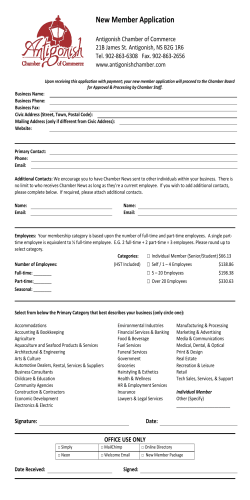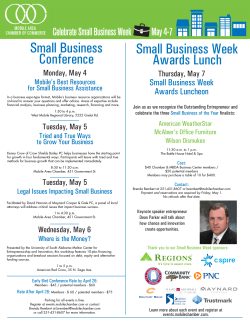
Cloud Chamber Activity - University of Birmingham
Cloud Chamber and Thorium Radioactive Decay (C. Lazzeroni and R.Lietava, University of Birmingham) 1.) Cloud Chamber Principle A diffusion cloud chamber visualises charged particle tracks. It was used in research from the beginning of 20 century. It was used for demonstration of particle properties of light (Compton effect, Nobel Prize 1927) and discovery of antimatter (positron, Nobel Prize 1936). Today it demonstrates the principle of how particle detectors work. Passing through matter, charge particles knock out electrons from atoms leaving trail of electrons and ions. Detection of these trails is the basic principle on which most of the particle detectors work. The principle of a diffusion cloud chamber can be understood from this picture. Fish tank contains air and alcohol vapour which diffuses from the container on the top. The temperature of the tank is 79° C at the bottom and 30° C at the top. The alcohol vapour follows the change of the temperature (see figure 2) and in the layer at the bottom of tank it is in oversaturated state when it almost condenses to liquid (see figure 3). The trail of charged ions created by charged particle passing the chamber leads to condensation of the vapour in the trail, producing clouds which you observe as a particle track. More Physics 1) Ionisation: charged particle traversing matter is knocking out electrons from atoms creating positively charged ions and free electrons. 2) Saturated Vapour Pressure: is the pressure exerted by a vapour in equilibrium with liquid at a given temperature in a closed system. 3) Oversaturated Vapour: the vapour pressure is higher than saturated vapour pressure. 4) α – particle: nucleus of 4He, it consists of 2 protons and 2 neutrons. 5) Radioactive decay: nucleus spontaneously emits particle. There are 3 types – α decay (α particle is emitted), β decay (electron or positron is emitted) and γ (photon is emitted) 6) Half-life time of radioactive element, abbreviated t½, is the period of time it takes for the amount of a substance undergoing decay to decrease by half. 7) 1 eV – energy unit used in particle physics. It is the amount of energy gained by the charge of a single electron moving across an electric potential difference of 1V. 2.) Rate of α-particles from welding rod (Measurement) The welding rod you have is made of tungsten with 2% of thorium oxide. Thorium is a naturally radioactive element which decays emitting an α particle with half-life time t1/2=1.4x1010 years. The kinetic energy of an alpha particle is 4 MeV. It travels several cm in air and 2.2 micrometers in tungsten. Your goal is to measure the rate of the decay, i.e. the number of decays per second. In the second part of the exercise you will compare your measurement with the theoretical estimate. 1.) Set up the cloud chamber according to the procedure described in section 4.) 2.) Count the number of tracks n from the rod during the time interval T. Recommended time interval T is between 30 seconds and one minute. Rate R of α particles is defined as R= n/T. 3.) Repeat the rate measurement N times, so you obtain N measurements of the rate R1,…,Ri,…,RN 4.) Calculate average rate <R> as: N < R >= ∑R i =1 i . N 5.) Plot a frequency histogram of the rate R, and from the width of the distribution estimate uncertainty of the measured rate due to random fluctuations in number of tracks, the so called statistical error. This should compare well with the result of the formula: N e= ∑ (< R > − Ri ) 2 i =1 N ( N − 1) N = < R2 > − < R >2 , where < R 2 >= N −1 ∑R i =1 N 2 i . 6.) Think about other biases in your measurement which may lead to a difference between your rate measurement and the actual rate, the so called systematic errors. 3.) Rate of α-particles from welding rod (Calculation) 1.) Calculate the mass m of Th in the rod. There are 2% of ThO2 in the rod. You can use scales and calliper to measure mass and dimensions.. Optionally, check 2% assumption by comparing measured rod density with theoretical 1 density ρ rod = ; ρThO2 =10g/cm3 and ρW=18.8 g/cm3. 0.02 / ρ ThO2 + 0.98 / ρW 2.) Calculate the number of thorium atoms N corresponding to the mass m: m N= N A . MTh= 232g is the molecular mass of Th. NA=6.023x1023 mol-1 is M Th the Avogadro number. 3.) Calculate the rate – number of decays per second – assuming an exponential decay N (t ) = N (0) x 2 − t / t1 / 2 . The thorium half - lifetime is t1/2=1.4x1010 years. Since the half-life time is much bigger than 1 second you can use the approximate N (t ) − N (0) ln(2) N (0) formula: Rate = = t t1 / 2 4.) For the final result, take into account that the typical range of α-particles in tungsten is δ=2.2 micrometers. So only the α-particles close to the surface survive. You need to calculate the effective rate as V Rateeffective = Rate ⋅ g ⋅ shell , VTot where g≈1/6 is the geometrical factor taking into account the direction of αparticles. Vshell is the volume of thin slice close to the surface and Vtot is the volume of the full cylinder. (Show that Vshell / Vtot ≈2δ/r, where r is the rod 2r δ radius.) Figure: Happy face indicates a αparticle which is lucky enough to escape from the rod as it is created close to the surface of the rod. Unhappy face is an α-particle which is absorbed in the rod as it is created far from the surface. 5.) Compare the result with your measurement. Is the calculation consistent with your measurement? If not, what can the possible reason be ? 4.) Cloud Chamber Manual List of parts: - fish tank with metal base - black taped base container for dry ice - foam sheet - fish tank cover – black metal plate with hole in the middle - alcohol in plastic squeezable bottle - plastic container for alcohol - two wire hooks - metal heater for alcohol - 1 power supply - lights - welding rod Start up: 1. Switch on the power supply of the metal heater 10 minutes before chamber operation. Voltage should be ~ 20 V with current about 0.3 A. Take plastic container, put the metal heater inside and fix the container to the top of the chamber with wire hooks. 2. Put the rod inside. 3. Add alcohol to the container (1 cm) 4. Take one bowl of dry ice. 5. Put the foam sheet inside the black-taped base container. 6. Put the dry ice on the foam and spread it evenly. 7. Put the fish tank inside the black-taped base container on the dry ice. It squeaks. 8. Close the fish tank with the black metal cover. 9. Check the horizontal/vertical adjustment of the chamber with a spirit level. 10. Put a black cloth on the chamber, leaving the front panel open. 11. Use LED lights to watch the base of the tank. 12. Wait 10-15 minutes until you see the tracks inside. Close up: 1. Switch off the power supply of the heater. 2. Open the chamber and dismount the alcohol container. 3. Take off the chamber from the black-taped base and leave everything open to dry. Safety: Do not drink or inhale alcohol Do not touch live cables Do not touch dry ice without gloves
© Copyright 2026









